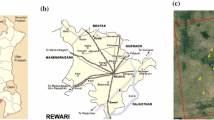Abstract
Radar backscattering coefficient has high dependence to dielectric constant of soil and many efforts have been done in the past to estimate soil moisture using Synthetic Aperture Radar (SAR). Soil moisture estimation in vegetated areas has some limitations and difficulties due to the effects of vegetation cover and soil surface roughness on radar backscattering coefficient. One of the widely used soil moisture estimation models in vegetated areas is Water Cloud Model (WCM) which has been improved and known as Improved Water Cloud Model (IWCM) recently. One way of improving soil moisture estimation accuracy in vegetated areas is to use optimum frequency and polarization band so as to minimize the effects of soil surface roughness and vegetation cover on radar back scattering coefficient. In this research, the accuracies of IWCM in different frequencies and polarizations have been assessed. The results showed that the IWCM has its highest accuracy in L-band, HV polarization mode. Also, by using the IWCM, sensitivities of radar waves to moisture of 0–3, 3–6 and 0–6 cm soil depths have been studied. The results demonstrated that radar waves have more sensitivity to the moisture content of 0–3 cm soil depth.






Similar content being viewed by others
References
Allen, P. B., & Naney, J. W. (1991). Hydrology of the Little Washita River Watershed, Oklahoma: data and analyses. USDA, ARS-90, 74, Washington, DC.
Alvarez-Mozos, J., Casali, J., Gonzalez-Audicana, M., & Verhoest, N. E. C. (2005). Correlation between ground measured soil moisture and RADARSAT-1 derived backscattering coefficient over an agricultural catchment of Navarre (North of Spain). Biosystems Engineering, 92, 119–133.
Attema, E. P. W., & Ulaby, F. T. (1978). Vegetation modelled as a water cloud. Radio Science, 13, 357–364.
Beljaars, A., Viterbo, P., Miller, M., & Betts, A. (1996). The anomalous rainfall over the United States during July 1993: sensitivity to land surface parameterization and soil moisture anomalies. Monthly Weather Review, 124, 362–383.
Champion, I. (1996). Simple modelling of radar backscattering coefficient over a bare soil: variation with incidence angle, frequency and polarization. International Journal of Remote Sensing, 15, 783–800.
Chander, G., Markham, B. L., & Helder, D. L. (2009). Summary of current radiometric calibration coefficients for Landsat MSS, TM, ETM+, and EO-1 ALI sensors. Remote Sensing of Environment, 113, 893–903.
Dubois, P. C., van Zyl, J., & Engman, T. (1995). Measuring soil moisture with imaging radars. IEEE Transactions on Geoscience and Remote Sensing, 33, 915–926.
Fung, A. K., Li, Z., & Chen, K. S. (1992). Backscattering from a randomly rough dielectric surface. IEEE Transactions on Geoscience and Remote Sensing, 30(2), 356–369.
Georgakakos, K. P., Guetter, A. K., & Sperfslage, J. A., (1997). Estimation of flash flood potential for large areas. In G. H. Leavesley, H. F. Lins, F. Nobilis, R. S. Parker, V. R. Schneider, & F. H. M. van de Von (Eds.), Destructive water: Water-caused natural disasters, their abatement and control (pp. 87–93). IAHS Publ. No. 239. Wallingford: IAHS Press.
Graham, A. J., & Harris, R. (2003). Extracting biophysical parameters from remotely sensed radar data: a review of the water cloud model. Progress in Physical Geography, 27, 217–229.
Jackson, T. J., & Cosh, M. H. (2006). SMEX03 regional ground soil moisture data: Oklahoma. Boulder: National Snow and Ice Data Center. Digital media.
Maity, S., Patnaik, C., Chakraborty, M., & Panigrahy, S. (2004). Analysis of temporal backscattering of cotton crops using a semiempirical model. IEEE Transactions on Geoscience and Remote Sensing, 42, 577–587.
Oh, Y., Sarabandi, F. T., & Ulaby, F. (1992). An empirical model and an inversion technique for radar scattering from bare soil surfaces. IEEE Transactions on Geoscience and Remote Sensing, 30, 370–381.
Prévot, L., Champion, I., & Guyot, G. (1993). Estimating surface soil moisture and leaf are index of a wheat canopy using a dual-frequency (C and W bands) scatterometer. Remote Sensing of Environment, 46, 331–339.
Saradjian, M. R., & Hosseini, M. (2011). Soil moisture estimation using multipolarization SAR images. Advances in Space Research, 48, 278–286.
Shi, J., Wang, J., Hsu, A. Y., O’Neill, P. E., & Engman, E. T. (1997). Estimation of bare surface soil moisture and surface roughness parameter using L-band SAR image data. IEEE Transactions on Geoscience and Remote Sensing, 35, 1254–1266.
Srivastava, H. S., Patel, P., Sharma, Y., & Navalgund, R. R. (2009). Large-area soil moisture estimation using multi-incidence-angle RADARSAT-1 SAR data. IEEE Transactions on Geoscience and Remote Sensing, 47, 2528–2535.
Taconet, O., Vidal-Madjar, D., Emblanch, C., & Normand, M. (1996). Taking into account vegetation effects to estimate soil moisture from C-band radar measurements. Remote Sensing of Environment, 56, 52–56.
Ulaby, F. T., Batlivala, P. P., & Dobson, M. C. (1978). Microwave backscatter dependence on surface roughness, soil moisture and soil texture. Part I—bare soil. IEEE Transactions on Geoscience and Remote Sensing, 17, 33–40.
Ulaby, F. T., Moore, R. K., & Fung, A. K. (1982). Microwave remote sensing, active and passive, volume II: Radar remote sensing and surface scattering and emission theory (p. 608). Norwood: Artech House.
Van Leeuwen, H. J. C., Clevers, J. G. P. W., & Rijckenberg, G. J. (1994). Synergetic use of optical and microwave remote sensing data using models and specific features with respect to the sugar beet crop. In Proceedings of the IEEE International Geoscience and Remote Sensing Symposium (IGARSS ‘94), California, CA, USA, August 8–12, 2, 827–831.
Acknowledgments
The authors would like to thank the Soil Moisture Experiment 2003 Science Team and USDA-ARS Grazinglands Research Laboratory for their assistance in the collection of this data set.
Conflict of Interest
The authors declare that they have no conflict of interest.
Author information
Authors and Affiliations
Corresponding author
About this article
Cite this article
Khabazan, S., Hosseini, M., Saradjian, M.R. et al. Accuracy Assessment of IWCM Soil Moisture Estimation Model in Different Frequency and Polarization Bands. J Indian Soc Remote Sens 43, 859–865 (2015). https://doi.org/10.1007/s12524-015-0455-3
Received:
Accepted:
Published:
Issue Date:
DOI: https://doi.org/10.1007/s12524-015-0455-3




